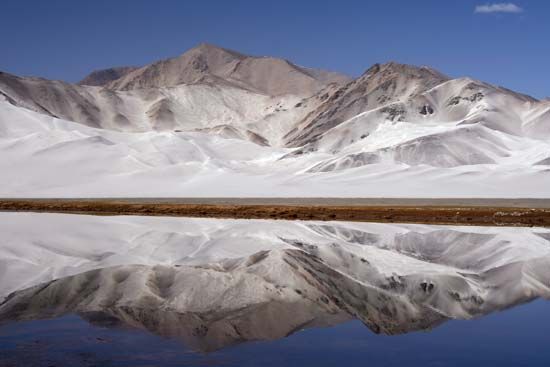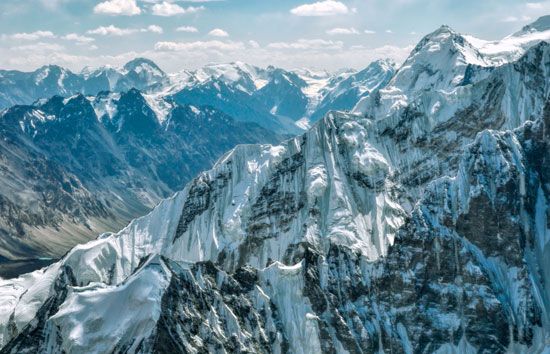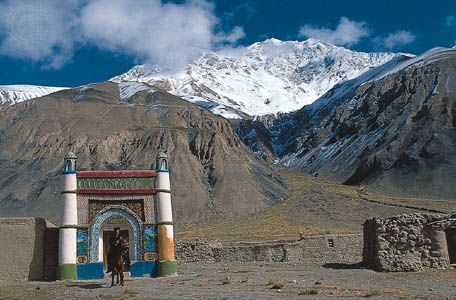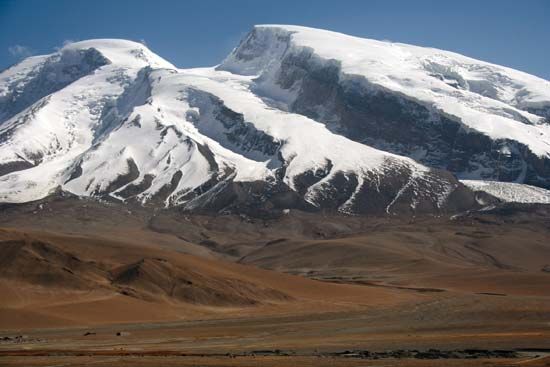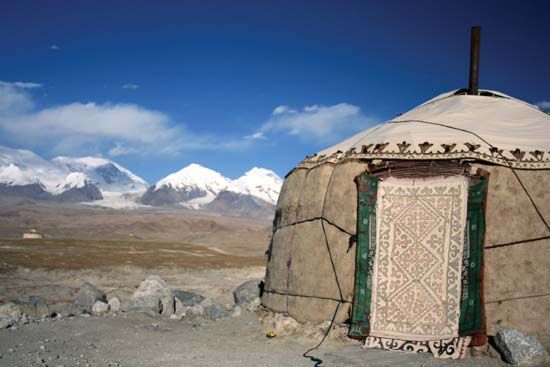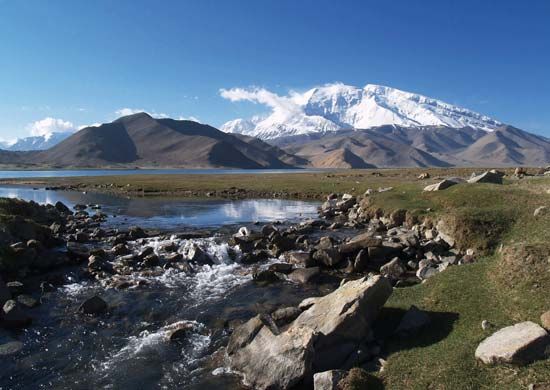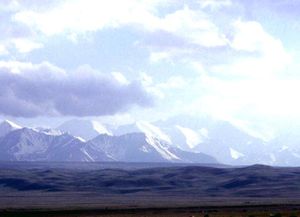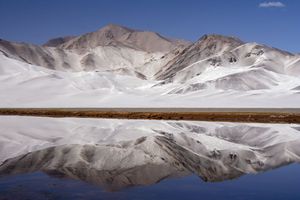Pamirs
- Also called:
- Pamir
- On the Web:
- Academia - Historical Geography of the Pamirs (Dec. 24, 2024)
Pamirs, highland region of Central Asia. The Pamir mountain area centres on the nodal orogenic uplift known as the Pamir Knot, from which several south-central Asian mountain ranges radiate, including the Hindu Kush, the Karakoram Range, the Kunlun Mountains, and the Tien Shan. Most of the Pamirs lie within Tajikistan, but the fringes penetrate Afghanistan, China, and Kyrgyzstan. The core of the Pamirs is in the highlands of Tajikistan, with the highest mountains in the Gorno-Badakhshan autonomous oblast (province).
The word pamir in the language of the region denotes the high undulating grasslands of the eastern portion of the mountains, especially where they abut Afghanistan and China. Deep river valleys mark the boundaries of the Pamirs in the north beyond the ridges of the Trans-Alai Range, and the valleys of the Vākhān region (Wakhan Corridor) of Afghanistan form the southern limit. The Sarykol pamir in the Uygur Autonomous Region of Xinjiang in western China bounds the eastern margin, and a series of southwestern-aligned valleys that eventually drain into the Vakhsh and Panj rivers serrate the western boundary.
Physical features
Physiography
The Pamirs are a combination of east-west and north-south ranges, with the former predominating. The east-west Trans-Alai Range, which forms the northern frame of the Pamirs, falls steeply to the intermontane Alai Valley. The high central part of the Trans-Alai, between the Tersagar Pass on the west and Kyzylart on the east, averages between 19,000 and 20,000 feet (5,800 and 6,100 metres), reaching its highest point at Lenin (Ibn Sīnā) Peak, 23,405 feet (7,134 metres). South from the Trans-Alai extend three north-south ranges. Of these the western, the Akademii (Akademiya) Nauk Range, and the central, Zulumart, are relatively short; the eastern, the Sarykol Range, forms the border between Tajikistan and China. The mountains east of the Sarykol Range are sometimes called the Chinese Pamirs.
The north-south Akademii Nauk Range extends into the northwestern Pamir system, where it rises into a huge barrier, reaching 24,590 feet (7,495 metres) in Imeni Ismail Samani Peak (formerly Communism Peak), the highest point in the Pamirs. The eastern flank of the Akademii Nauk Range is covered on the south face by the Fedchenko Glacier. The western flank intersects other ranges that lie still farther to the west: the Peter I Range, with Moscow (Moskva) Peak (22,260 feet [6,785 metres]); the Darvaz Range, with Arnavad Peak (19,957 feet [6,083 metres]); and the Vanch and Yazgulem ranges, with Revolution (Revolyutsii) Peak (22,880 feet [6,974 metres]). The ranges are separated by deep ravines. To the east of the Yazgulem Range, in the central portion of the Pamirs, is the east-west Muzkol Range, reaching 20,449 feet (6,233 metres) in Soviet Officers Peak. South of it stretches one of the largest ranges of the Pamirs, called Rushan on the west and Bazar-dara, or Northern Alichur, on the east. Still farther south are the Southern Alichur Range and, to the west of the latter, the Shugnan Range. The extreme southwestern Pamirs are occupied by the Shakhdarin Range, composed of north-south (Ishkashim Range) and east-west elements, rising to Mayakovsky Peak (19,996 feet [6,095 metres]) and Karl Marx (Karla Marksa) Peak (22,067 feet [6,726 metres]). In the extreme southeast, to the south of Lake Zorkul (Sarī Qūl), lie the east-west Vākhān Mountains.
It is customary to divide the Pamirs into a western area and an eastern area, distinguished by their forms of relief. In the eastern Pamirs a medium-mountain relief predominates on a high raised foundation. While the heights above sea level average 20,000 feet (6,100 metres) or more, the relative heights of the peaks above their foundation do not in most cases exceed 3,300 to 5,900 feet (1,000 to 1,800 metres). The ranges and massifs have mainly rounded contours, and the wide and flat-bottomed valleys and troughs between them, situated at heights of 12,100 to 13,800 feet (3,700 to 4,200 metres), are occupied either by quietly running, meandering rivers or by dry channels. The valleys and slopes of the ranges are covered by layers of loose material.

In the western Pamirs the relief is high-mountain and sharply disjointed, alternating between low ranges and alpine ridges capped by snow and glaciers; and there are deep, narrow ravines with high, rapid rivers. The valleys and depressions are filled with outwash debris, so that almost the only suitable places for human settlement are the alluvial fans in the valleys of tributaries of the Panj River. The transition from the eastern-Pamirs type of relief to the western-Pamirs type occurs gradually. The conventional boundary is a line joining the ridge of the Zulumart Range with Karabulak Pass in the Muzkol Range; from Pshart Pass it follows the ridge of the Northern Alichur Range to Lakes Yashil and Sarez, where it turns south to the valley of the Pamir River.
Drainage
Like the adjacent Hindu Kush and Karakoram mountains to the south, the Pamirs exhibit considerable glaciation as a result of high winter snowfall. The Fedchenko Glacier dominates the central Pamir massif, with other glaciers, similarly named for 19th-century Russian scientists (e.g., Garmo and Grumm-Grzhimaylo), feeding into it. Glaciation is less extensive in the Alai and Trans-Alai mountains.
Some meltwater from the Pamirs flows to the Tarim Basin in western China, but the vast bulk drains into the Panj and Vakhsh rivers and their tributaries. There are large irrigation projects associated with the Kyzylsu-Surkhob-Vakhsh river system (each of the rivers flows successively into the next). The Amu Darya (ancient Oxus River), formed by the confluence of the Vakhsh and the Panj, conveys meltwater to other irrigation projects downstream. Earthquakes occasionally generate landslides that dam rivers to produce lakes. Lake Sarez in the Murgab River valley is dammed by a massive landslide that was probably initiated during an earthquake.



